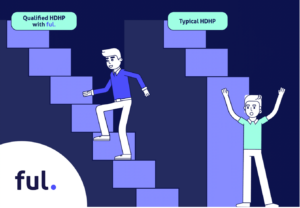By: Dr. Bernie Saks, President & CEO at ful.
Whether moving into a new home, starting a new job, or changing health insurance coverage, transitions—even those made for the better—can be difficult. And oftentimes the perception of the new home, new job, or new insurance is based more upon the transition itself than the new endeavor.
Transitioning from a traditional health plan to a high deductible health plan (HDHP) normally presents some anguish among even the most loyal employees.

Think about the typical scenario in which most people are introduced to high deductible health plans. An employer must respond to increasing premiums (averaging 6-10% year over year), which may be detrimental to the overall financial well-being of the business itself.
How does the employer take care of their bottom line AND their highly regarded employees?
By shifting to an HDHP, the employer reduces “premium” costs. This may help the business stay afloat, but unfortunately, places a greater financial burden on the employee. The employer wishes to take care of their employees but finds that they are “caught between the rock,” the financial solvency of the business, “and the hard place,” providing the level of benefits that retain and attract employees.
What may have been an individual $500 deductible previously now becomes a $1500 deductible. For many families, that can mean the difference in making ends meet. In such a scenario, how could a high deductible plan be well-received?
At ful., we’ve created a better way to transition to an HDHP, and a better way to leverage health savings accounts (HSAs) to benefit both plan members and the employer’s bottom line.
Shift Some Premium to Participating Members to Make Your Health Plan Perform Better
Healthcare costs are driven by waste and inefficiency. It is estimated that up to 25% of all U.S. healthcare spending represents waste. In 2022, this waste was greater than $1 trillion (shocking, right?).
The two largest waste centers are unnecessary services and ineffectively delivered services. Together, they create overutilization. Combined with a lack of price transparency, these waste centers continue to grow—unchecked—as sick and unsavvy plan members are determined to get what they pay for. These are the factors that drive claims costs and year-over-year premium increases.
If we really wish to control cost for health plan payors and their plan members, we must reduce the waste. Effectively reducing waste requires investment in plan members, bringing them to the fight by shifting some of the premium to their health savings account. By right sizing the reward for their efforts to participate in savvy healthcare consumer education, their HSA provides access to care when they need it and creates a tax-free savings. This cannot be done with traditional health plans.
It Just Makes Sense
For the price of a traditional health plan, an HDHP can be self-funded, and the “premium” difference (savings) can be used to prefund members’ HSAs to much better outcomes. In such a scenario, the employee will have money earmarked for medical events at the beginning of the policy year with additional monthly cash distributions to participating members’ HSAs as they complete gamified (fun and effective) training.
When premium dollars are aligned with participating members, the individual will be more likely to preserve and maintain their healthcare dollars while judiciously seeking the care they need, when they need it.
HDHP’s have lower monthly premium costs. HSA’s create long-term health savings.
HSA balances roll over year to year, so members can build up reserves to pay for healthcare items and services they need later. So, by using these tools in conjunction with education, it just makes sense that all plan stakeholders benefit by this new way to HSA.
Savings on Top of Savings
In the end, I believe that an HDHP, combined with meaningful cash rewards for members participating in simple, healthcare education, will do more than create savvy healthcare consumers. ful. not only provides a smooth, seamless transition to an HDHP, the thoughtful way it moves money through the healthcare system provides savings on top of savings and a much richer benefit solution for employers.